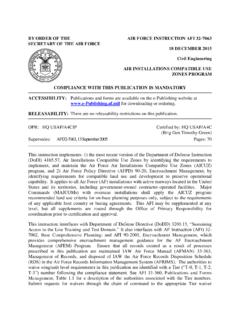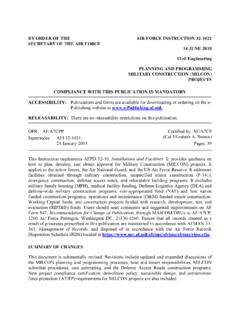Transcription of BY ORDER OF THE AIR FORCE INSTRUCTION 32-1002 …
1 BY ORDER OF THE AIR FORCE INSTRUCTION 32-1002 . SECRETARY OF THE AIR FORCE . 22 JANUARY 2015. Civil Engineering SNOW AND ICE CONTROL. COMPLIANCE WITH THIS PUBLICATION IS MANDATORY. ACCESSIBILITY: Publications and forms are available for downloading or ordering on the e-Publishing website at RELEASABILITY: There are no releasability restrictions on this publication OPR: AF/A4 CXS Certified by: AF/A4CX. (Col Valerie L. Hasberry). Supersedes: afi32 -1002, Pages: 24. 19 October 2011. This INSTRUCTION provides guidelines and procedures for the Air FORCE Snow and Ice Control Program.
2 It implements Air FORCE policy directive (AFPD) 32-10, Air FORCE Installations and Facilities. This publication applies to all Air FORCE , Air FORCE Reserve Command (AFRC), and Air National Guard (ANG) units and personnel. This publication may be supplemented at any level, but all direct Supplements must be routed to the Office of Primary Responsibility (OPR) of this publication for coordination prior to certification approval. The authorities to waive wing/unit level requirement in this publication are identified with a Tier ( T-0, T-1, T-2, T-3 ).
3 Number following the compliance statement. See Air FORCE INSTRUCTION (AFI) 33-360, Publications and Forms Management, for a description of the authorities associated with the Tier numbers. Submit requests for waivers through the chain of command to the appropriate Tier waiver approval authority, or alternately, to the Publication OPR for nontiered compliance items. Refer recommended changes and questions about this publication to the OPR using the AF Form 847, Recommendation for Change of Publication; route AF Forms 847 from the field through the appropriate functional chain of command.
4 Ensure that all records created as a result of processes prescribed in this publication are maintained in accordance with Air FORCE Manual (AFMAN). 33-363, Management of Records, and disposed of in accordance with the Air FORCE Records Disposition Schedule (RDS) located in the Air FORCE Records Information Management System (AFRIMS). The use of the name or mark of any specific manufacturer, commercial product, commodity, or service in this publication does not imply endorsement by the Air FORCE . 2 afi32 -1002 22 JANUARY 2015. SUMMARY OF CHANGES.
5 This document has been substantially revised and must be completely reviewed. Major changes include the addition of Tier wavier authority requirements, updated office symbols, and updated references. Chapter 1 KEY INSTRUCTIONS 4. Applying the Snow and Ice Control Plan (S&ICP).. 4. Snow and Ice Control (S&IC) Objective.. 4. Supporting the Mission.. 4. Prioritizing Snow Removal.. 4. Using References and Resources.. 5. Chapter 2 RESPONSIBILITIES 6. The Director of Civil Engineers (AF/A4C).. 6. AFCEC: .. 6. MAJCOMs: .. 6. Installations: .. 6. Non-Air- FORCE -Owned Installations (Other Services and Commercial).
6 7. Snow and Ice Control Committee (S&ICC) Members.. 8. Chapter 3 SNOW AND ICE CONTROL (S&IC) PREPARATIONS 13. Operator Readiness.. 13. Snow Removal Readiness.. 14. Obtaining Materials and Parts.. 14. Protecting Air FORCE Property.. 15. Streamlining Operations.. 15. Establishing the Snow Control Center (SCC).. 15. Chapter 4 SNOW AND ICE CONTROL OPERATIONS 17. Maintaining Communications.. 17. Facility Managers.. 17. Airfield Ice Control.. 17. Table Standard Gradation for Sand.. 18. Snow Clearing Principles.. 18. Snow Disposal.. 18. afi32 -1002 22 JANUARY 2015 3.
7 Attachment 1 GLOSSARY OF REFERENCES AND SUPPORTING INFORMATION 20. Attachment 2 USING ICE CONTROL CHEMICALS ON AIRFIELD PAVEMENTS 23. 4 afi32 -1002 22 JANUARY 2015. Chapter 1. KEY INSTRUCTIONS. Applying the Snow and Ice Control Plan (S&ICP). Ground Support. Installations with over 150 millimeters (6 inches) of average annual snowfall will maintain a S&ICP and form a snow and ice control committee (S&ICC). For installations which receive less than 150 millimeters (6 inches) of average annual snowfall, the installation commander will create plans and committees to meet their specific needs.
8 (T-1). Aircraft Support. Specific anti-icing/deicing procedures for aircraft maintenance are maintained in the technical orders (TO) for each type of aircraft. A forum similar to the S&ICC should be used to coordinate the aircraft anti-icing/deicing program. Note: Aircraft anti-icing/deicing products and general procedures are listed in TO 42C-1-2, Anti- Icing,Deicing and Defrosting of Parked Aircraft. Snow and Ice Control (S&IC) Objective. Begin runway S&IC operations removal just prior to, or at the onset of, snowfall or icing conditions to provide continuous bare pavement.
9 Installations without a flying mission will establish when S&IC operations should begin according to mission requirements. The snow control center (SCC), command post, Airfield Management (AM), and Air Traffic Control Tower (ATCT) must maintain close communications at all times. (T-3). Supporting the Mission. Maintain continuous mission capability by removing snow and ice from airfield and base pavements. Judge the success of the program by the safe movement of aircraft and vehicles during inclement winter weather. Prioritizing Snow Removal. S&IC from all paved surfaces typically cannot be accomplished simultaneously; therefore, three priorities are established to ensure S&IC.
10 Operations are accomplished in ORDER of relative mission importance and publicized to avoid misunderstandings among base agencies. Priorities can be changed when directed by the S&ICC. chair, in the best interest of flight safety and/or airfield mission requirements. Joint basing priorities will be determined during the S&ICC meeting. (T-1) Maps will be color-coded in the following manner: Priority 1: Red; Priority 2: Yellow; Priority 3: Green. (T-2). For safe operation of vehicles and equipment, establish a primary access route to and from the airfield.











